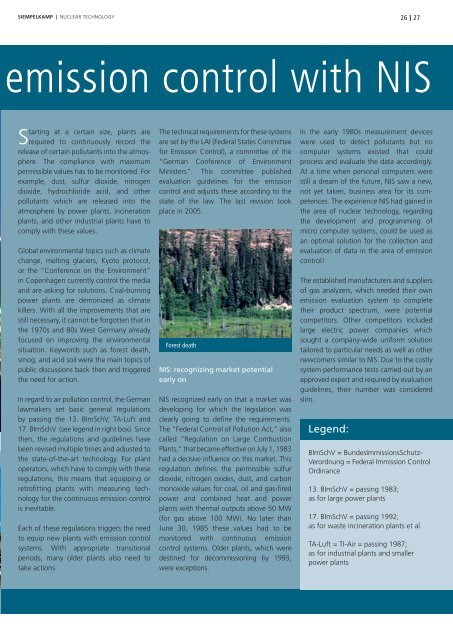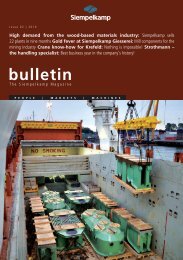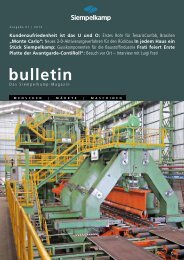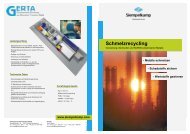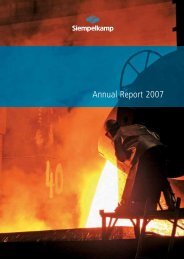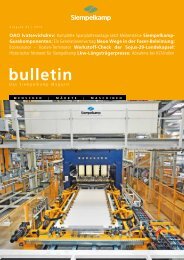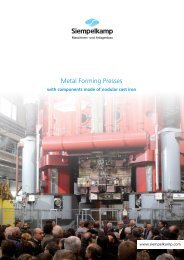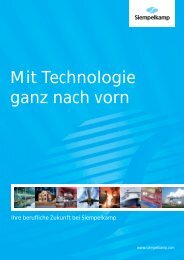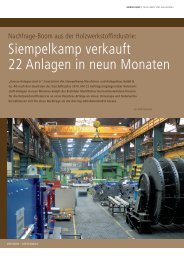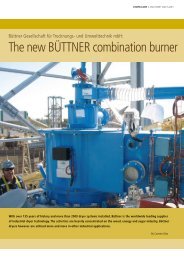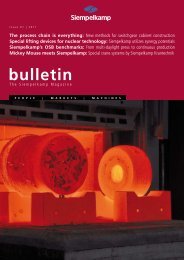Bulletin 1/2010 - Siempelkamp NIS
Bulletin 1/2010 - Siempelkamp NIS
Bulletin 1/2010 - Siempelkamp NIS
You also want an ePaper? Increase the reach of your titles
YUMPU automatically turns print PDFs into web optimized ePapers that Google loves.
SIEMPELKAMP | NUCLEAR TECHNOLOGY<br />
emission control with <strong>NIS</strong><br />
Starting at a certain size, plants are<br />
required to continuously record the<br />
release of certain pollutants into the atmosphere.<br />
The compliance with maximum<br />
permissible values has to be monitored. For<br />
example, dust, sulfur dioxide, nitrogen<br />
dioxide, hydrochloride acid, and other<br />
pollutants which are released into the<br />
atmosphere by power plants, incineration<br />
plants, and other industrial plants have to<br />
comply with these values.<br />
Global environmental topics such as climate<br />
change, melting glaciers, Kyoto protocol,<br />
or the “Conference on the Environment”<br />
in Copenhagen currently control the media<br />
and are asking for solutions. Coal-burning<br />
power plants are demonized as climate<br />
killers. With all the improvements that are<br />
still necessary, it cannot be forgotten that in<br />
the 1970s and 80s West Germany already<br />
focused on improving the environmental<br />
situation. Keywords such as forest death,<br />
smog, and acid soil were the main topics of<br />
public discussions back then and triggered<br />
the need for action.<br />
In regard to air pollution control, the German<br />
lawmakers set basic general regulations<br />
by passing the 13. BImSchV, TA-Luft and<br />
17. BImSchV (see legend in right box). Since<br />
then, the regulations and guidelines have<br />
been revised multiple times and adjusted to<br />
the state-of-the-art technology. For plant<br />
operators, which have to comply with these<br />
regulations, this means that equipping or<br />
retrofi tting plants with measuring technology<br />
for the continuous emission control<br />
is inevitable.<br />
Each of these regulations triggers the need<br />
to equip new plants with emission control<br />
systems. With appropriate transitional<br />
periods, many older plants also need to<br />
take actions.<br />
The technical requirements for these systems<br />
are set by the LAI (Federal States Committee<br />
for Emission Control), a committee of the<br />
“German Conference of Environment<br />
Ministers”. This committee published<br />
evaluation guidelines for the emission<br />
control and adjusts these according to the<br />
state of the law. The last revision took<br />
place in 2005.<br />
Forest death<br />
<strong>NIS</strong>: recognizing market potential<br />
early on<br />
<strong>NIS</strong> recognized early on that a market was<br />
developing for which the legislation was<br />
clearly going to defi ne the requirements.<br />
The “Federal Control of Pollution Act,” also<br />
called ”Regulation on Large Combustion<br />
Plants,” that became effective on July 1, 1983<br />
had a decisive infl uence on this market. This<br />
regulation defi nes the permissible sulfur<br />
dioxide, nitrogen oxides, dust, and carbon<br />
monoxide values for coal, oil and gas-fi red<br />
power and combined heat and power<br />
plants with thermal outputs above 50 MW<br />
(for gas above 100 MW). No later than<br />
June 30, 1985 these values had to be<br />
monitored with continuous emission<br />
control systems. Older plants, which were<br />
destined for decommissioning by 1993,<br />
were exceptions.<br />
26<br />
27<br />
In the early 1980s measurement devices<br />
were used to detect pollutants but no<br />
computer systems existed that could<br />
process and evaluate the data accordingly.<br />
At a time when personal computers were<br />
still a dream of the future, <strong>NIS</strong> saw a new,<br />
not yet taken, business area for its competences.<br />
The experience <strong>NIS</strong> had gained in<br />
the area of nuclear technology, regarding<br />
the development and programming of<br />
micro computer systems, could be used as<br />
an optimal solution for the collection and<br />
evaluation of data in the area of emission<br />
control!<br />
The established manufacturers and suppliers<br />
of gas analyzers, which needed their own<br />
emission evaluation system to complete<br />
their product spectrum, were potential<br />
competitors. Other competitors included<br />
large electric power companies which<br />
sought a company-wide uniform solution<br />
tailored to particular needs as well as other<br />
newcomers similar to <strong>NIS</strong>. Due to the costly<br />
system performance tests carried out by an<br />
approved expert and required by evaluation<br />
guidelines, their number was considered<br />
slim.<br />
Legend:<br />
BImSchV = BundesImmissionsSchutz-<br />
Verordnung = Federal Immission Control<br />
Ordinance<br />
13. BImSchV = passing 1983;<br />
as for large power plants<br />
17. BImSchV = passing 1992;<br />
as for waste incineration plants et al.<br />
TA-Luft = TI-Air = passing 1987;<br />
as for industrial plants and smaller<br />
power plants


